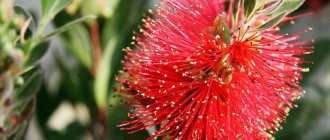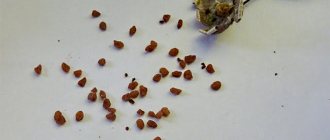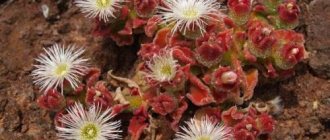Author: Elena N. https://floristics.info/ru/index.php?option=com_contact&view=contact&id=19 Category: Houseplants Published: February 22, 2019Last edits: June 01, 2021
- Reproduction methods
- Nephrolepis exaltata
The plant nephrolepis (lat. Nephrolepis) belongs to the genus of ferns of the Lomariopsis family; in some classifications it is classified as a member of the Davalliaceae family. The Latin name is derived from the Greek words “nephros” and “lepis”, meaning “bud” and “scale” in translation and containing a hint of the shape of the veil. About 30 species of nephrolepis grow in nature, distributed throughout the world, but the homeland of the nephrolepis plant is the shady forests of the tropics of Africa, America, Australia and Southeast Asia. In culture, nephrolepis fern is used as a potted or hanging plant to decorate interiors - in addition to being very beautiful, nephrolepis fern perfectly purifies the air.
Planting and caring for nephrolepis
- Flowering: does not bloom.
- Lighting: diffused light (near the window, as well as on the northern, western or eastern windowsill). The plant requires 14-16 hours of daylight.
- Temperature: during the growing season – 20-24 ˚C, during the dormant period – about 15 ˚C.
- Watering: the higher the temperature in the room, the more often and more abundantly you need to water. There is only one principle: the substrate is moistened as the top layer of soil in the pot dries.
- Humidity: high. Frequent spraying, periodic showers and keeping on a tray with wet pebbles are recommended.
- Fertilizing: from March to September 3-4 times a month with complex fertilizers for decorative deciduous plants. When wintering in a warm room, one feeding per month is sufficient.
- Dormant period: from October to February.
- Transplantation: young plants are replanted annually, adults - once every 2-3 years.
- Reproduction: vegetative only: suckers, shoots and dividing the bush.
- Pests: aphids, whiteflies, spider mites, rootbugs and scale insects.
- Diseases: loss of decorativeness due to improper care and dry air.
Read more about growing nephrolepis below.
Why do spots and plaque appear on fern leaves, the main pests and diseases of the plant
Also, if yellowing or other spots or plaque is detected on the fronds, it is necessary to inspect the flower for pests and diseases. If they are identified, the necessary measures must be taken immediately. However, it is important to understand that with proper planting and care, the risk of fern infection is very low.
House fern pests
The most common fern pest is the scale insect. Unfortunately, the plant does not always signal externally about the creeping parasite, and only after some time, when the infection has reached its peak, the fronds begin to dry out and fall off. Another difficulty in detecting scale insects is that they settle at the base of leaves and often cannot be distinguished from plant spores. Affected leaves must be pruned along with the petiole. Scale insects are removed mechanically by scraping them off with a brush. The plant is treated with Actellik (15-20 drops / 1 liter of water).
Also, the reason that the house fern dries out can be a spider mite, which causes harm by sucking the juices from the plant and likes to make cobwebs on it. The leaves wither, turn yellow and fall off.
If watering is improper, nematodes may develop in the roots. In this case, only replanting a flower with Actellik treatment can help.
If the air in the room is too dry, the fern can be attacked by aphids and whiteflies. In case of severe infection, spraying with Actellik, Karbofos, Aktara and other drugs will help. Mealybugs also cause yellowing of foliage
Indoor fern diseases
Low temperatures and excessive watering can provoke the development of fungal diseases, such as gray rot, sooty fungus, etc. When these diseases appear, it will be too late to look for information on how to cure indoor fern. It is better to promptly protect the diseased plant from healthy ones in order to avoid infection. The use of fungicides will most likely be ineffective.
The best fight in this case will be to prevent the occurrence of diseases - maintaining the required level of soil and air moisture and favorable temperatures.
Botanical description
Nephrolepis flower is a herbaceous plant, epiphytic or terrestrial, with a short rhizome, a rosette of light green, short-petioled pinnately compound leaves up to 70 cm long, consisting of lanceolate, serrate-crenate along the edge of segments up to 5 cm long, on the lower side of which on both sides the midrib contains round sori. With age, the leaves turn yellow and fall off. Leafless shoots, covered with scales and easily rooting, extend from the rhizome.
Soil preparation
The soil for indoor ferns should be loose, allowing air and water to pass through. Stagnant moisture causes root rot. It is desirable that the soil contains a lot of rotted leaves and a little less pine needles and peat.
Ferns need soil with slightly increased acidity (pH is 5.0-6.6). The parameter is easily established using litmus paper. Soil (2 g) must be mixed with distilled water (10 ml). Shake the mixture and let it sit for a while. Then you need to lower litmus paper into the liquid above the sediment. At pH = 5 it will be yellow, and at 6 it will be greenish-yellow.
Caring for nephrolepis at home
Growing conditions
If you decide to purchase indoor nephrolepis, you first need to familiarize yourself with the conditions for its cultivation. Indoor fern nephrolepis prefers diffused light, so it would be better to place it near a window where direct sunlight does not reach.
If you prefer to keep flowers on window sills, windows of northern, western or eastern orientation are suitable for nephrolepis. However, the length of daylight hours in the plant's natural habitat is 14-16 hours, so if you want to see the house fern nephrolepis in its best form, be prepared to provide additional lighting for it. Nephrolepis is tolerant of fluorescent lamps, so it can often be seen in hotel lobbies and large office centers.
- Luffa at home: care and types
The optimal temperature regime for fern in the warm season is 20-24 ºC, but with frequent spraying of the leaves it can withstand higher temperatures. In winter, comfortable conditions for resting nephrolepis are a temperature of about 15 ºC, but the main thing is to keep the plant as far as possible from heating devices. If you do not have the opportunity to place the plant in a cool room during the dormant period, leave it in its usual place and continue spraying and watering - nephrolepis will continue to develop, although not as intensely as in the summer.
Caring for nephrolepis fern includes regular feeding of the plant with complex fertilizers for ornamental foliage plants in a concentration equal to one-fourth of that specified by the manufacturers. Fertilizing is applied approximately three to four times a month from March to September - provided there is a cool winter, the plant does not need fertilizers for the rest of the year. If the fern remains warm in winter, then you can feed Nephrolepis in winter no more than once a month.
Watering
As for watering nephrolepis, its frequency and water consumption at a time depend on the temperature in the room: the higher it is, the more frequent and abundant the watering should be. The top layer of soil in the pot should dry out between waterings. If the indoor plant nephrolepis rests in cool conditions in winter, it does not need frequent watering and large amounts of water - watering is carried out as the top layer of soil dries.
To organize a high humidity regime for a plant in the warm season, it is recommended to spray its leaves with non-cold, settled water as often as possible and it is advisable to give nephrolepis a shower at least once a month. You can keep the fern on a tray with wet pebbles or expanded clay so that the bottom of the pot does not touch the water. By the way, nephrolepis also needs to be watered with settled or filtered water at room temperature.
Transfer
Young ferns are replanted every spring, adults - once every two to three years. It is preferable to grow nephrolepis in a plastic container rather than a ceramic one - plastic retains moisture in the soil longer. Since the plant’s root system is superficial, choose a shallow, wide pot for it. Before transplanting nephrolepis, place a layer of expanded clay in the new pot so that excess water does not stagnate in the roots of the plant, then place a layer of substrate in it.
The soil for nephrolepis should be light: high-moor peat, greenhouse and coniferous soil in equal parts. It is advisable to add a little bone meal to the soil mixture in a proportion of 5 g per 1 kg of soil. If you don’t want to bother with making a soil mixture, purchase a ready-made acidic substrate for ferns in the store, although nephrolepis will also be suitable for soil for camellias, calla lilies or hydrangeas with a pH value of 4.5-5.5. When transplanting, the root collar is left above the soil surface. The transplanted plant initially needs constantly moist soil and high air humidity.
- How to transplant and propagate poinsettia
Pests and diseases
Nephrolepis at home with insufficient care is affected by whiteflies, aphids, scale insects and spider mites. You can cope with these harmful insects by treating the plant with insecticides Actellik, Aktara and similar preparations.
Sometimes readers ask why nephrolepis leaves dry out. Most often, nephrolepis dries out from insufficient or infrequent watering. If only the tips of the leaves dry out, this is a sign that the air humidity level in the room is low for the plant.
If leaves turn brown, curl, and fall off, it may be due to drafts, low temperatures, or watering with cold, chlorinated, or hard water. When dry spots appear on fern leaves, these are most likely burns from direct sunlight.
Properties of nephrolepis
It is believed that nephrolepis absorbs energy and electromagnetic radiation harmful to humans, improves immunity, instills vigor, and cleans the air of dust and harmful fumes. You can keep nephrolepis at home, placing it near the TV or next to the computer, or you can grow it in the office, and it will be in place everywhere. Psychologists say that proximity to nephrolepis reveals perseverance, perseverance and prudence in a person - precisely those qualities that we all lack, however, it should be borne in mind that tobacco smoke reduces the effect of these wonderful properties of the plant.
Why fern leaves turn yellow, care mistakes
Nephrolepis is an unpretentious plant with a fast growth rate. Usually tolerates room conditions well - humidity, temperature. However, there are times when a flower needs help to overcome unfavorable factors or cope with a disease. This is especially true in the off-season, at the beginning of the heating season or immediately after its completion.
If you suddenly begin to notice that your indoor fern has begun to look worse, is growing poorly, its leaves are turning yellow and drying, we advise you to take a test to determine whether you are caring for it correctly and whether you are keeping it in comfortable conditions.
Reproduction of nephrolepis
Reproduction methods
Nephrolepis reproduces by dividing the rhizome, shoots and suckers. The fact is that many varieties of this genus are sterile, and even if they form spores, they do not convey the characteristics of the mother plant. That is why nephrolepis is propagated vegetatively at home.
Dividing the bush
Usually the bush is divided in the spring, at the same time as the plant is replanted. Only large plants that have several growing points can be divided. The cuttings, each of which must have at least one growing point, are planted in a separate plastic container, watered and rooted, creating conditions of high humidity at a temperature of 15-18 ºC. However, do not expect quick success: for normal development, the divisions need to build up the root system, and this takes time.
Reproduction by offspring
Nephrolepis tendrils (leafless shoots) are taken to the side and buried in a bowl with light soil to a depth of 0.5-0.8 cm, leaving the tops above the surface. During rooting of the shoots, the soil in the bowl should be slightly moist at all times. After 10-15 days, the shoots take root, and after another time, new shoots appear. When the plants become stronger, they are separated from the mother plant and transplanted into individual containers.
- Indoor cypress: cultivation, types and varieties
Common growing questions
Nephrolepis is an indoor fern that is highly decorative. The plant is very popular among gardeners because it is very easy and pleasant to care for.
Fern, or nephrolepis (lat. Nephrolepis) is a very beautiful decorative foliage flower, which is popular both among gardeners for planting in open ground and among gardeners who plant it indoors. However, often the owners of the fern are upset by the fact that the leaves of the flower turn yellow and dry, or, as they are correctly called in this plant, fronds. If you look at the most popular threads on online gardening forums, you will find that this is a very common problem. And the reasons why the fern turns yellow lie in improper care.
In this article, we have selected a list of the most common mistakes that are made when growing this hanging plant at home and provoke the occurrence of indoor fern diseases. By preventing them, you can count on the fact that nephrolepis will delight you with its lush green bushes for a long time.
Types and varieties
Not many types of nephrolepis are grown in culture, but we will tell you about the most popular ferns.
Nephrolepis exaltata
In nature, it is an epiphyte or terrestrial herbaceous plant with a vertical rhizome, on which a rosette of large, pinnately compound light green leaves up to 70 cm long on short petioles develops. The leaves consist of lanceolate segments up to 5 cm long, serrate-cense along the edges. As they age, the leaves turn yellow and fall off. On the underside of the segments on both sides of the midrib, sori with spores mature. Scale-covered lashes (stolons) are formed on the rhizome, which easily take root. Nephrolepis sublime is native to the tropical regions of Southeast Asia.
This species has many garden forms and varieties:
- nephrolepis Roosevelt - a large fern with fronds with wavy segments sticking out in different directions;
- nephrolepis Maasa - a compact variety with wavy leaves;
- Nephrolepis Scott is also a small plant with segments curled at the edges;
- nephrolepis Green Lady is a very beautiful fern with a lush fountain of openwork wavy leaves with a pointed tip, crowning a vertical rhizome;
- Nephrolepis Emina is a low-growing compact variety with almost erect fronds with curly leaves with carved teeth along the edges;
- Nephrolepis Boston, or Nephrolepis Bostonian, is an upright growing plant that was bred in the USA and literally immediately became popular among breeders: on its basis, varieties were bred with double-, triple- and quadruple-pinnate fronds reaching a length of 120 cm, the segments of which depend on varieties can be wavy or twisted:
- nephrolepis Hills and Fluffy Raffles - ferns with double-pinnate leaves;
- Whitman's nephrolepis is a plant with triply pinnate leaves;
- nephrolepis Smith - nephrolepis with four-pinnate leaves.
Nephrolepis cordifolia
It differs from Nephrolepis sublime by swellings on underground shoots, similar to tubers, covered with silver or white scales, and also by the fact that its fronds, with a denser, sometimes tiled arrangement of rounded segments, are directed upward almost vertically. Nephrolepis cordifolia is native to subtropical forests of both hemispheres; this species has been in cultivation since 1841; it is often used to make bouquets.
Nephrolepis biserrata
Originally from Central America. It is distinguished by long leaves, sometimes reaching 2-2.5 m in length in greenhouse conditions. Nephrolepis ensiform can only be grown in large rooms.
Why do fern leaves turn yellow after transplantation?
A prerequisite for fern care is its replanting. It is recommended to carry out this procedure every year in April-May until the plant reaches the age of three years. After that - once every two to three years. When transplanting, choose a slightly larger container.
It should not be too deep, but wide enough, slightly larger than the root system of the plant.
It should be noted that nephrolepis does not always tolerate this procedure easily and quickly. He needs time to lay down new vines. What to do if you have just transplanted a fern, but it begins to dry out? First of all, it is necessary to provide the plant with all the conditions that it prefers, and wait a couple of months until it adapts.
If you have chosen the right soil and pot, it is important to understand that frequent changes in conditions also entail a change in the appearance of the fern - this is how it becomes capricious due to being disturbed. At this point, you need to remove the dried leaves.
- Author: Maria Sukhorukikh
Rate this article:
- 5
- 4
- 3
- 2
- 1
(0 votes, average: 0 out of 5)
Share with your friends!
Nephrolepis - signs
Fern nephrolepis is a very popular plant, maybe that’s why there are legends about it, it is the central character of many superstitions and signs. Some talk about the positive effect of the plant on human health and the environment, while others attribute witchcraft properties to nephrolepis that can influence a person’s fate. An ancient legend says that none of the people could see the fern flower, because on the night of Ivan Kupala, when it blooms, it is plucked by an invisible hand, and all sorts of mystical horrors await those who go into the forest in search of this flower.
Another belief says that the fern scares away evil spirits, protects the house from evil witchcraft and black magic, preventing the evil eye or damage from being cast on the owners. They also say that fern brings success in business, has a positive effect on material well-being - it attracts money into the house, protects its owners from irrational actions and impulsive spending. It is said that there have been cases of sudden enrichment that are associated with the presence of ferns in the house.
If people of different temperaments live in a house, fern helps to establish good harmonious relationships between them. Under the influence of his aura, aggressive manifestations of people’s character are softened, temper goes away, and confrontation is smoothed out. This is probably why nephrolepis is called the “golden mean” plant.
Which of the stories about ferns is true and which is fiction, everyone decides for themselves. However, I must say that I personally have not felt any negative effects of indoor nephrolepis on my life. For me, nephrolepis is a non-capricious, spectacular plant that brings beauty to the house, purifies the air in the apartment and creates a cozy atmosphere. And let me finally give you some advice: do not be afraid to grow nephrolepis in your home and do not listen to those who themselves live with fears and prejudices.
Difficulties
If the fern is not cared for properly, it will get sick. The following pests often appear:
- Nematode. Appears when watering with cold water and chlorine. The leaves will be yellow and dry. The only way to save it is to transplant it into a new pot, which is pre-treated with insecticides. But treatment is not always successful; sometimes the fern dies.
- Scale insects, thrips, aphids. They usually start on a fern that is located in a room where the air is too dry. Regular spraying and a warm shower can prevent damage to the flower. If pests still appear, the plant must be treated with insecticides.
Diseases and pests are not all the problems that gardeners face. Plants react sensitively to inappropriate conditions, which is why they become yellowed and dry. Ferns dry out due to:
- low or high temperature (more than 25 degrees);
- using cold water;
- watering with liquid containing a lot of chlorine;
- dry air, presence of heating devices near the flower;
- exposure to direct sunlight;
- growing in a cramped pot or lack of nutrients in the soil.
Therefore, it is important to provide suitable conditions for the plant. Even minor violations can cause these problems.
Exalted
This species is considered the most popular because it is quite easy to grow indoors. The fern has a high root with a perpendicular placement, large feathery foliage and a non-capricious character. It develops normally in an environment with high humidity and when it is deficient. You can see what the Nephrolepis Exalted variety looks like in the photo below:
Nephrolepis sublime
General characteristics of the plant
Fern is one of the sought-after plants for gardeners; it is easy to care for and has a lush bush of green shoots up to 1 m long. Such branches are called fronds. They, in turn, consist of small carved leaves located on the stem in a checkerboard pattern. Translated from Greek, the very name of the flower means “bud” and “scales”. Despite the voluminous foliage, the root of the fern is small, which allows it to be grown in a small pot or hanging planter, which only emphasizes its grace.
Nephrolepis often choose tree trunks as a habitat, but they are epiphytes and do not harm the tree. They lend themselves well to breeding, and florists are constantly developing new varieties.











